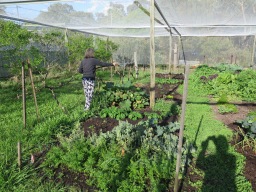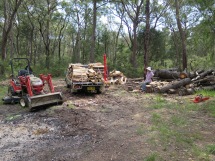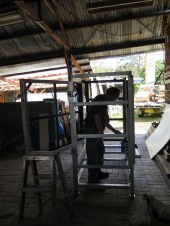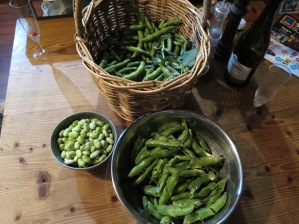Monthly Archives: October 2015
Two Wood Firings in One Week
Two Wood Kiln Firings in One Week
I have decided that I can fit in one extra firing before the Southern Highlands Arts Festival – Arts Trail, Open Studios weekends on the 7th & 8th of November, then again on the 14th & 15th.
The kiln is unpacked and repacked while it is still warm.
For some unexplainable reason, I wake up just after 3 am in the morning. Or is it still very late at night? I’m not too sure, but I’m wide awake, so I get up and walk down to the pottery workshop in the dark. It is quite overcast tonight/this morning, as there are no stars to be seen up in the blackness where the sky ought to be.
It’s so pitch black and very quiet, it seems a shame to make any noise at all. I decide to only put one light on and work in the soft ambiance and stillness. I make the kindling fire from the scraps of wood that fractured off from the bigger logs as I was splitting them yesterday. I spent most of the day yesterday in cutting, splitting and then, with Janine’s help, stacking it. We stacked half of it onto the truck. A very full load without sides on the tray. I drove it down to the kiln shed, covered it with a tarp against the possibility of rain overnight.

I cut all the straight log wood into hob lengths, avoiding the branched bits. These, I cut around and leave aside for splitting into small short pieces for use at the beginning of the firing, when I start the fire on-the-floor of the firebox. This first stage of the firing gently heats the pots up from cold, but also serves to build up a pile of embers in the base of the firebox which is necessary to ignite the big logs later on in the firing process.
Every part of the tree is used. I don’t like to use branched bits for the longer hob wood, as it doesn’t split easily or well, often coming apart into horrid, sprawling, jagged pieces that are difficult shapes to stack and stoke, so I have developed a technique of spacing my chain saw cuts to get the maximum number of full length ‘hob’ wood pieces from the straight grained sections of the log and a smaller number of knotty, branched bits left in-between for use as floor wood lumps. I usually walk along the log with my metal measuring stick and mark off all the cuts with a red wax crayon. This takes a little time, but makes the cutting and sizing much faster and more accurate overall.
The kindling fire starts well and develops slowly into a full firebox of burning chunks, after 3 hours, there is enough ember built up in the lower part of the fire box, (‘the ash-pit’) on the floor, to support the fire starting off on the hobs, in the upper part of the firebox (‘on the hobs’). The long, thick pieces of wood introduced onto the ‘hobs’ from the top of the firebox, are held suspended by the brick ‘hobs’ just above the burning embers in the ash pit, placed here, they soon catch alight and start to burn fiercely. This takes the firing to another level, where the wood burns cleanly and thoroughly, allowing the temperature to rise evenly and steadily, up until it is time to begin reduction at about 1000oC.
After cutting and stacking the kiln wood yesterday, I spent the rest of the afternoon in grinding, fettling, filing, acid-etching, washing and baking the newly galvanised kiln frame for Sturt Workshops prior to etch-priming. This is all mindless dull work that I have done a hundred times before, if not more and a good time to allow my mind to settle and watch itself wander, constantly returning to the hand/arm action of simple brushing. Paint on, Paint off. I don’t need to be in a buddhist temple in Kyoto to practice mindfulness. Any place will do, but it helps to be able to make the time for it and it alone.
Although it is very early in the morning, I’m keeping myself occupied in fiddling with the very small fire in the fire box. I need to watch it carefully, as at this stage it can easily go out if it is left for any
period of time unattended. As I sit and carefully place each new small piece of wood on the pyre, I suddenly realise that it is starting to rain. No wonder that there were no stars in the sky. This is no problem for me, as I took the precaution to cover the wood outside on the truck last night. I’m using freshly split pine, which although being felled two years ago, is still damp inside when split from the log. I don’t want it to get any wetter until the firing is up to 1000oc. or more, then it won’t matter if the wood is wet and may even be of some use in creating the ‘reduction’ atmosphere in the kiln, which changes the colour of the clay bodies and glazes. Such is the odd nature of burning wood in a potter’s kiln. Pottery may seem superficially to be a simple craft activity, but there is a whole world of science, chemistry and associated technologies that need to be learnt, assimilated and internalised, so that you can then work intuitively and creatively in the medium.
In this firing I have 3 large jars and then a lot of bottles, with a few shelves of smaller domestic pots underneath. This firing isn’t very efficiently packed, but there is no easy way to get these big round jars into a more-or-less square box of a kiln chamber. That is just the way it is, so I do the best that I can with what I have to work with.
I have done this so many times, that I have judged the amount of wood needed, down to the the last half wheel barrow load. The firing proceeds smoothly and evenly right up to top temperature of 1300oC or cone 10 flat, in 16 hours. Because I started so early this morning, there is time for a hot shower and a relaxed dinner back up in the house, even a bottle of wine to celebrate. This is civilised kiln firing. Perhaps even Laid back ?
We bake a whole snapper for dinner with some freshly picked broad beans from the garden. The are perfect just now. Sweet and juicy without any starchiness at all, just the way that I love them. This is the 2nd pick and there will probably another couple before they get too big. The first few beans are eaten raw as an entre, perfect with a glass of chilled white wine. We bake a few potatoes, sweet potato, red onions and some pumpkin. Our garden feeds us very well!
I bake the fish with some mushrooms and slices of lemon and serve it dressed with a sauce of melted butter with finely chopped anchovies, capers and green olives.
It’s a tough life, but some one has to have a go at it.
Tomorrow I will start to grind, sort and clean all the pots from the last firing, spend a bit more time in the garden and add another coat of paint to the kiln frame waiting in the factory.
Never a dull moment!
fond regards from the multi-tasking Steve and Janine
Hitting the Ground Running
I’m just back from Japan, It’s been a great trip. I’ve been away since late August. I’m back just in time to discover that my friend and mentor, Allan Parkes has just died. Such an interesting and creative person.
For the first time, I decided to rent some studio space in Japan and make some work there. It was very good. I hope that I’ve learned something while I’ve been away, but one never knows. Only time will tell. I tend to take things in and let them blend and simmer for a while, then hope that something will percolate back out again in some dilute form that will enhance and extend what I already do with what I know. If nothing useful emerges, then there is nothing lost, as I really enjoyed my time there. As I alway do. I have a strong affinity for Japan, the people, the food, the creative endeavours of all those people that I have met and/or whose work I have seen in the Galleries.
I had one day to unpack and do my washing, then straight in to the pottery and kiln factory. I have a large kiln ordered, so it’s straight into welding mode. I have to earn some money. I weld up the steel frame and get it off to the galvanisers in just 4 days. While the kiln is away. I get stuck into glazing all the bisque fired pots that I left here in the pottery, before I went to Japan. So it’s glazing, decorating and kiln packing. Then wood stacking, kiln shelf grinding, cleaning and washing. Finally the kiln is packed and ready to fire.
It’s 5 o’clock in the morning and the early bird chorus is just starting. I’m down in the kiln shed firing the kiln, I like to get an early start for my firings. For some very intimate psychological/physiological reason that I don’t really understand, I seem to like to get an early start, when it’s dark and quiet and I have the whole world to myself. Well, almost. There is of course the odd rooster in the distance and the bird song. The birds seem to start calling to each other even before I’m aware that that there is any change in the light levels, but they are so much more sensitive to the natural world than I am. We have all learnt to live in an un-natural modified environment with electric lights, refrigeration, supermarkets, air con, and flat screens. I eschew most of this for the frugal comfort of home grown vegetables and a wood fire for warmth and cooking. Of course I do have electric lights and a fridge. I’m not a ludite, but I’m trying to keep my life as simple as I can, while still engaging with the modern world.
Half an hour later, I can start to see a slight lightening of the sky and instead of it being jet black, it starts to have a very pale light grey to bluish tinge to it. I’m sure that if I had to live without any modern ‘conveniences’, that I’d soon adapt to my circumstances and start to see the dawns approach, just like the birds. But at this stage I’m happy in my hybrid world, sitting on the edge of my small hamlet, with access to everything that a modern first world economy has to offer only half an hour away and I’m also happy to live here quietly and ignore most of it.
Electricity is great. We make all of our own. In fact we make about 3 times more than we use, and sell the excess 2/3rds into the grid for money. Having fresh drinking water on tap is also a great thing. We catch all our own rain water from our roof and store it for later use. Hot water on tap has to be the greatest luxury ever invented. I consider it the basic standard of civilisation. If you have hot water, you probably have peace and stability. We make our own hot water from a combination of solar panels and a boiler fitted into the back of our wood fired kitchen stove. We also own a fridge, a small one, but we don’t own a freezer, even though we have a large kitchen garden and could find a use for one. We thought about it and decided against it, as it uses too much electricity. We always have something fresh to pick and eat from the garden. We eat what is in season in the garden, what we have over, we vacuum preserve it in ‘Vacola’ jars and store it away in the pantry.





I’m perfectly aware that the way we live is both very hard work and a great luxury. We are in control of most aspects of our life and that is our greatest luxury. However, Just like everyone else living in a capitalist economy, we have to earn money to pay the bills that constantly accrue. Such things as Council rates, insurance, registration, taxes etc. There are lots of once-off bills that occur throughout the year, but add up to be our major expenses over-all. As we don’t have conventional jobs, cash flow can sometimes be a problem, but we manage by living quite frugally. Luckily, most of the things in life that we aspire to can’t be bought for cash, but are earned through hard graft and personal effort.
This wood firing will be the last that we can fit in before the Southern Highlands Arts Festival Open Studio Weekends, that are slated for the first two weekends in November. It gives us a couple of weeks to unpack the kiln and then fettle and grind all the pots. With any luck, we should have just enough time to unpack the kiln, then clean up the studio ready for the opening.
Best wishes from Steve who is glad to be back home again and hitting the ground running
Vale Allan Parkes
Allan Parkes was a really good person to get to know. I was very lucky to have spent 25 years working with him at the old East Sydney Technical College. He was a great character. I really enjoyed our conversations. He seemed to be very well-educated, but I remember him telling me that he was brought up in the country on a property, with an absent father, who was away working in Sydney, earning the money to support the venture. So perhaps Allan was home schooled? Whatever his formal education, he had a wonderful speaking voice with particularly clear diction. Perhaps a result of some private schooling? (I learned at Allan’s funeral service that he was educated remotely by the ‘school of the air’ and by correspondence schooling. His beautiful diction and hand writing were a result of his self imposed and determined effort to ‘improve’ himself. A defiantly independent individual.) He was very well read and could converse on a wide range of topics. He always seemed to be borrowing books from the Art School Library on a regular basis.
He was a fine mentor in my early days there at the ‘Tech’. He was one of the ‘elders’ who helped grow me up. I admired him and remember him very fondly.
He came and stayed with us at our home in Balmoral Village on one occasion in the 80’s and gave me a lesson on how to cut and dress sandstone, to make the window sills for our house. I learnt a lot in a very short time and went on to carve all the sandstone window sills for our house over the next 9 months. I’m a slow worker. Allan gave me one of his pitching tools which I still have and even now, 30 years later, it still gets occasional use, as I’m currently building a new stone retaining wall at our property.
He often greeted me with “Hello Citizen” A reference to the French republic, but there was a lot more going on there, not all of which I ever got to the bottom of, but I enjoyed listening to his stories of working as a drover up in the Gulf country. I remember stories of restoration stonework on some big churches, carving the gargoyles for the Government House in The Domain. Very interesting and sad stories of his time as a news correspondent in Burma during the war. Some very brief descriptions of his detention and torture by the Japanese forces there. His discussions of French faience pottery. The need for more colour in the brown and green 70’s ceramics (which was a very accurate and timely prediction, that later came to pass), he was interested in organic gardening, native plant propagation, red wine, water-colours, sculpture. So many topics. He was so erudite, cultured, well read and he had a beautiful hand. We have a few notes and letters from him and even though they are hastily draughted, the lettering is exquisite.
I met him, when I first enrolled at ESTC in 1971. At that time he was the Technical Assistant in the Ceramics Dept. He was immediately engaging, supportive and helpful. Always ready with some advice and ideas to get the most out of my time there. Although he was only the TA in the Dept. he actually taught me more than some of the full-time staff that were employed there.
I recall going to him early in my first year as a student at the Tech and complaining about how I was so unhappy with my work that had just emerged from the kiln. He put one hand on my shoulder, looked me straight in the eye and said, “I know that you might feel disappointed just now, but I know that you will go straight back out there and make a better one”. I didn’t know that at all! But once he told me, I realised that I could, and so I did.
I didn’t know his history and what he had gone through in the war at that time. I must have appeared to him as a soft, spoilt, indulged, whingeing, middle-class brat, but he didn’t tell me that. What he told me, was to get over it and go and make another one, only not just one, but ten more. Good advice, well received, and because I did, we got on really well after that.
Janine and I used to call in at his home in Concord West at times during the 70’s when we lived in Dural and found ourselves passing by. He was still married to Helen in those days and we met Freya Marc and Manon there. Helen used to lend me her books on Native plant propagation and cultivation. It was Helen and Allan, who introduced us to the work of Edna Walling and that had yet another great effect on our lives. We are still keen native gardeners to this day.
Janine and I have spent some time reflecting and remembering Allan with great fondness during the past week, since we heard of his passing. He was so very good to us both at different times during our student years and then later in different ways. He always seemed so European in outlook, while also being so quintessentially Australian. He drank red wine when everyone was drinking beer. He drank beer when everyone switched to red, when wine became trendy. When boutique breweries evolved and both wine and beer became trendy, he drank cognac. A true individual, he owned a vehicle for his stone mason’s business, when no-one else could afford one, later, he caught public transport when everyone else drove.
He was never far from a roll-your-own cigarette, always rolled rather shakily from some intensely dark, very strong, Dutch tobacco. Later, when his hands became a bit too shaky for roll-your-owns, he switched to cigars.
He was a good artist and multi-skilled. I knew him as a sculptor in stone, ceramics, ice and butter. He often crafted images in butter or ice for use as center-pieces in table settings for big events in the food school at ESTC. This is an ancient tradition that very few people were aware of and skillful in – except of course Allan. He was also a very good water-colourist as well. I remember seeing his design sketches for the new sandstone drive-in gate at ESTC. He did a beautiful design and accompanying water-colour image. I didn’t know until recently, that he had also painted in oils in his latter years.
Allan was asked to repair the gargoyles on Government House in the Domain. He refused the job to re-create the old European originals. Instead, he submitted all new designs based on Australian native animals. I remember going there one day to visit him on-site. He was just finishing off the echidna corner piece. He had a natural gift for sculpture, which he honed through hard work and practice. The gargoyles looked strange up close when viewed on the ground, but suddenly emerged in perfect perspective once they were installed up in the parapet and viewed from 50 feet below. How did he know how to get that sense of perspective just right? He was very good! Allan also designed and built the copper cockerel weather-vane on the roof of the old circular library building at ESTC. This image was later adapted to become the logo for the Art School. As far as I know, it’s still up there. Look for it the next time you visit the National Art School.
Allan left his mark in so many ways on the people that he interacted with and on the very real structural fabric of Sydney itself. Not many people can say that.
So we all have our own Allan in our minds eye and memories. We all come here today to add our own little bit to the complex picture of the complete man.
Citizen Parkes, well-read, complex, deep, richly informed, engaging.
Fondly remembered, sadly missed.
A funeral service will be held for Allan at Rookwood Cemetery, West Chapel, on Tuesday 13th of October at 2.00pm.
















































You must be logged in to post a comment.